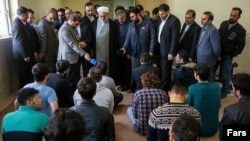Nearly a month since anti-government protests in Iran took place, arrests continue while the government has not released any details about more than 8,000 people estimated to be already jailed since November 15.
The Chief of Police in the oil-rich province of Khuzestan, southwest Iran, claimed on Friday, December 13 that his forces had identified and arrested 136 people across the region for carrying and using unlicensed firearms.
The Islamic Republic Government's official news agency, IRNA, cited Heydar Abbaszadeh as saying that in a "relentless campaign" against people carrying unlicensed guns and buying and selling weapons and ammunition, as well as those responsible for firing weapons, the security forces along with other special units and the Islamic Republic Judiciary, identified and arrested 136 suspects in the previous five days.
However, the Islamic Revolution Guards Corps (IRGC) Brigadier General Abbaszadeh stopped short of disclosing more details, such as how many were exactly accused of using firearms.
Moreover, he did not elaborate on when and where the shootings took place. He merely said that police had earlier issued an order for the arrest of individuals who open fire at houses, residential complexes, stores, and vehicles.
"The security forces discovered 21 military weapons, 190 hunting rifles, and 990 different types of bullets at the suspects' hiding places," Abbaszadeh maintained.
Carrying guns among the mainly Arabic-speaking tribes in Khuzestan is quite common, and traditionally used for firing into the air during celebrations such as wedding parties.
Based on multiple estimates, including the New York Times, between 30 to 100 people were shot dead during the mid-November anti-regime protests only in the city of Mahshahr and its townships in Khuzestan.
The government has claimed that armed protesters fired at security forces in Mahshahr without providing any evidence, but eyewitnesses say while a few people were seen carrying guns, the vast majority of protesters were unarmed and many were killed by heavy machine-gun fire when they fled and were hiding in marshes at the edge of a township.
Almost a month after the mid-November protests against an overnight three-fold increase in gasoline prices, the Islamic Republic is still reluctant to officially declare the number of people fallen victim to the security forces' heavy-handed and deadly response to the uprising.
While Amnesty International has confirmed the deaths of at least 208, opposition groups have put the number around 400, and U.S. officials have said it could be as high as 1,000.
In the meantime, arresting people suspected of participating in the protests continues.
The IRGC-linked news agency Fars reported on Friday that its Intelligence Organization arrested four people for being royalists in the province of Isfahan, central Iran.
Fars has identified the detainees as the members of an unknown group called "Isfahan's Homeland Combatant Network."
Without referring to its source, Fars reported, "The four were arrested at the residence of one of the members while holding a session to discuss the second wave of riots."
Riot is a term used by the Islamic Republic Supreme Leader, Ayatollah Ali Khamenei and his allies for describing the recent protests that turned into widespread rallies against the clergy-dominated establishment in Iran.
"Several 'Lion and Sun' flags (Iranian national flag before the Islamic Revolution), tools for writing slogans on the walls, and petrol bombs were discovered at the gathering in Isfahan," Fars claimed.
In the recent protests, hundreds of enraged demonstrators chanted slogans in favor of Iran's last royal dynasty, including the exiled Prince Reza Pahlavi and his mother, the former queen of Iran Farah Diba.






